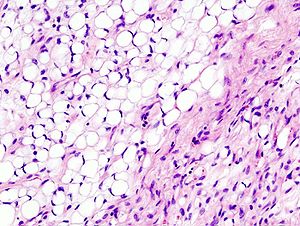미소이드 지방종
Myxoid liposarcoma| 미소이드 지방종 | |
|---|---|
 | |
| 허벅지의 깊은 연조직에서 발생하는 myxoid 지방종의 조직병리학적 이미지. H&E 얼룩 | |
| 전문 | 종양학 |
myxoid 지방종은 역사학적으로 mxoid 외관의 악성 지방 조직 신엽이다[1].
Myxoid Liposarcomas는 두 번째로 흔한 형태의 지피종이며, 사지에 있는 모든 지피종 중 30~40%를 대표하며, 특히 허벅지, 엉덩이, 복강경, 몸통, 발목, 근위부 대들보, 머리와 목, 손목에서 가장 흔히 발생한다. 그것들은 순환근육면체 또는 심층부에서 발생한다. 그들은 크고 느리게 자라고 고통 없는 덩어리로 나타난다.[2]
이들 신엽세포의 신소성세포는 두 가지 융합유전자 중 하나를 생성하는 염색체 번역을 포함하고 있는데, 두 가지 융합유전자 중 하나는 약 90%의 FUS-DDIT3와 최대 10%의 myxoid 지방종 환자에서 EWSR1-DDIT3 융합유전자다.[3] FUS-DDIT3 융합 유전자는 일반적으로 16번 염색체의 짧은 팔(또는 "p")의 밴드 11.2에 위치한 FUS FET 유전자 계열 유전자의 일부와 12번 염색체의 긴 팔(또는 "q")의 밴드 13.3에 위치하는 DDIT3 ETS 전사 인자 계열 유전자의 일부가 결합하여 형성된다. 이 융합 유전자는 t(12;16)(q13;p11)로 표기되어 있다.[4][5] 임상 전 연구, 즉 실험실 연구에서는 FUS-DDIT3 융합 유전자가 mxoid liposarmas의 개발을 촉진하기 위한 유전자의 역할을 할 수 있다고 제안한다.[6] EWSR1-DDIT3 융합 유전자는 22번 염색체 q 암의 밴드 12.2에 위치한 EWSR1 FET 유전자 계열 유전자가 DDIT3 유전자의 일부와 결합하여 형성된다. 이 융합 유전자는 t(12;22) (q13;12)로 표기되어 있다.[7][8][9]
추가 이미지
40세 남성의 왼쪽 축관 부위에서 높은 등급의 myxoid 지방종 MRI. 수평 단면.
참고 항목
참조
- ^ "Orphanet: Myxoid/round cell liposarcoma". Orpha.net. Retrieved October 27, 2019.
- ^ Sung; et al. (2000). "Myxoid Liposarcoma: Appearance at MR Imaging with Histologic Correlation". RadioGraphics. 20 (4): 1007–1019. doi:10.1148/radiographics.20.4.g00jl021007. PMID 10903690.
- ^ Flucke U, van Noesel MM, Siozopoulou V, Creytens D, Tops BB, van Gorp JM, Hiemcke-Jiwa LS (June 2021). "EWSR1-The Most Common Rearranged Gene in Soft Tissue Lesions, Which Also Occurs in Different Bone Lesions: An Updated Review". Diagnostics (Basel, Switzerland). 11 (6): 1093. doi:10.3390/diagnostics11061093. PMC 8232650. PMID 34203801.
- ^ Aman P, Ron D, Mandahl N, et al. (1993). "Rearrangement of the transcription factor gene CHOP in myxoid liposarcomas with t(12;16)(q13;p11)". Genes Chromosomes Cancer. 5 (4): 278–85. doi:10.1002/gcc.2870050403. PMID 1283316. S2CID 1998665.
- ^ Göransson M, Andersson MK, Forni C, et al. (January 2009). "The myxoid liposarcoma FUS-DDIT3 fusion oncoprotein deregulates NF-kappaB target genes by interaction with NFKBIZ". Oncogene. 28 (2): 270–8. doi:10.1038/onc.2008.378. PMID 18850010.
- ^ Owen I, Yee D, Wyne H, Perdikari TM, Johnson V, Smyth J, Kortum R, Fawzi NL, Shewmaker F (September 2021). "The oncogenic transcription factor FUS-CHOP can undergo nuclear liquid-liquid phase separation". Journal of Cell Science. 134 (17). doi:10.1242/jcs.258578. PMC 8445604. PMID 34357401.
- ^ Rabbitts TH, Forster A, Larson R, Nathan P (1993). "Fusion of the dominant negative transcription regulator CHOP with a novel gene FUS by translocation t(12;16) in malignant liposarcoma". Nat. Genet. 4 (2): 175–80. doi:10.1038/ng0693-175. PMID 7503811. S2CID 5964293.
- ^ Crozat A, Aman P, Mandahl N, Ron D (1993). "Fusion of CHOP to a novel RNA-binding protein in human myxoid liposarcoma". Nature. 363 (6430): 640–4. Bibcode:1993Natur.363..640C. doi:10.1038/363640a0. PMID 8510758. S2CID 4358184.
- ^ Forni C, Minuzzo M, Virdis E, et al. (February 2009). "Trabectedin (ET-743) promotes differentiation in myxoid liposarcoma tumors". Mol. Cancer Ther. 8 (2): 449–57. doi:10.1158/1535-7163.MCT-08-0848. PMID 19190116.
외부 링크
| 분류 |
|---|




